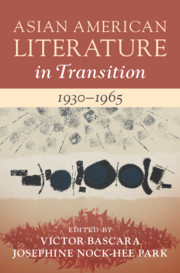Book contents
- Asian American Literature in Transition, 1930–1965
- Asian American Literature In Transition
- Asian American Literature in Transition, 1930–1965
- Copyright page
- Contents
- Figures
- Contributors
- Series Preface
- Introduction
- Part I Transitions Approached through Concepts and History
- Part II Transitions Approached through Authors, Texts, Concepts, and History
- Chapter 8 Lin Yutang and the Invention of Asian America, 1949
- Chapter 9 H. T. Tsiang Against the World
- Chapter 10 “A Congressman from India”
- Chapter 11 Younghill Kang, Transpacific Agent
- Chapter 12 Transition and Obliteration
- Chapter 13 America Is in the Heart as Postcolonial Pastoral
- Chapter 14 Bienvenido Santos
- Chapter 15 Women Writing War in Asia/America
- Chapter 16 Japanese Incarceration, Settler Colonialism
- Chapter 17 Jade Snow Wong and the Making of Model Minority Democracy
- Chapter 18 A Little Bit of Form Goes a Long Way
- Chapter 19 Richard Eun-kook Kim
- Select Bibliography
- Index
Chapter 10 - “A Congressman from India”
Dalip Singh Saund in Cold War America
from Part II - Transitions Approached through Authors, Texts, Concepts, and History
Published online by Cambridge University Press: 27 May 2021
- Asian American Literature in Transition, 1930–1965
- Asian American Literature In Transition
- Asian American Literature in Transition, 1930–1965
- Copyright page
- Contents
- Figures
- Contributors
- Series Preface
- Introduction
- Part I Transitions Approached through Concepts and History
- Part II Transitions Approached through Authors, Texts, Concepts, and History
- Chapter 8 Lin Yutang and the Invention of Asian America, 1949
- Chapter 9 H. T. Tsiang Against the World
- Chapter 10 “A Congressman from India”
- Chapter 11 Younghill Kang, Transpacific Agent
- Chapter 12 Transition and Obliteration
- Chapter 13 America Is in the Heart as Postcolonial Pastoral
- Chapter 14 Bienvenido Santos
- Chapter 15 Women Writing War in Asia/America
- Chapter 16 Japanese Incarceration, Settler Colonialism
- Chapter 17 Jade Snow Wong and the Making of Model Minority Democracy
- Chapter 18 A Little Bit of Form Goes a Long Way
- Chapter 19 Richard Eun-kook Kim
- Select Bibliography
- Index
Summary
In 1956, Dalip Singh Saund was elected as Representative of California’s 29th district, becoming the first Asian American member of the US Congress. This chapter approaches Saund’s 1960 memoir Congressman from India with particular attention to his complicated role as a “representative,” in multiple senses of the term – as a representative in the US Congress, but also in his various embodiments as a Sikh, an Indian, and an American. Published during his second term, Congressman is a carefully calibrated performance, in which Saund narrates his story as a sort of proto-model minority tale and constructs the USA as a global ally to Asia during the Cold War. Despite the tale of immigrant achievement and his indefatigable optimism, racial inequality persists as a theme throughout, and this chapter examines two moments in the memoir where the politics of race play a key role: his 1956 campaign for Congress; and his tour through Asia as an ambassador one year later. In attending to these moments, this chapter asks, how did the pressures of Cold War ideology impact how Saund rendered his past and how he imagined American and Indian futures? And how did his narrative shape the climate for the wave of South Asian immigrants who would soon arrive in the USA with the passing of the Hart–Celler Act five years later?
- Type
- Chapter
- Information
- Asian American Literature in Transition, 1930–1965 , pp. 177 - 194Publisher: Cambridge University PressPrint publication year: 2021



